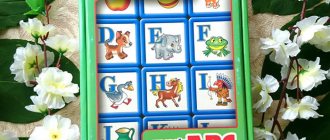MAGAZINE Preschooler.RF
In accordance with the approval and implementation of the Federal state requirements for the structure of the basic general educational program of preschool education (Order of the Ministry of Education and Science of the Russian Federation No. 655 of November 23, 2009), Federal state requirements for the conditions for the implementation of the basic general educational program of preschool education (Order of the Ministry of Education and Science of the Russian Federation No. 2151 dated July 20, 2011) the educational process in kindergarten is currently undergoing changes. The structure of the main general education program of preschool education has changed, which is considered as a model for organizing the educational process.The main feature of the organization of educational activities in preschool educational institutions at the present stage is the departure from educational activities (classes), increasing the status of play as the main activity of preschool children; inclusion in the process of effective forms of work with children: ICT, project activities, gaming, problem-based learning situations as part of the integration of educational areas. We want to share our experience in organizing educational activities at a morning group meeting, which is one of the forms of organizing the educational process in joint activities with children, where the child can show his speech activity, communication during the morning group meeting is an important routine moment. Morning gathering for preschoolers is, first of all, an opportunity to spend a few minutes together, which is important for shy children, to tell them what they think and feel. For teachers, morning assembly provides an opportunity to create an atmosphere of collective creativity, which helps to develop a sense of mutual respect and kindness among students. Consequently, one of the main requirements for a teacher’s professional skills is the ability to manage children’s interpersonal communication, resolve conflict situations, and organize creative joint activities. Svirskaya L.V. in her book she set the following tasks for a group meeting: · create a positive emotional mood for the whole day - “set the tone”; · provide conditions for interpersonal and cognitive-business communication between children and adults; · activate children’s skills regarding communication, planning and organizing their own activities; · choose the topic of a new project together with the children; · develop a plan for the implementation of a new project; · summarize the project; · instill communication culture skills; · support the desire to agree on joint activities, distribute roles and responsibilities; · teach: - formulate judgments, give reasons for statements, defend your point of view; - select the most significant, interesting events from personal experience, talk about them briefly, but consistently and logically; - listen carefully, show a constructive attitude towards the statements of others; - explain your emotional state in words and correct it; - make a choice; - plan your own activities. For more fruitful work on the development of the child, we have identified the main stages of the morning gathering: - greeting; -working with the calendar; -telling news; -discussion of the topic; -advertising activities in activity centers; -children’s choice of activity centers. Using the example of organizing activities with children at a group meeting during the project “Everyone around you knows that health is your best friend,” I will show how the tasks of developing children’s communication skills were solved. The morning gathering begins with a greeting. Before the start of which, the children and I pay attention to the stands “I have come”, “Birthday Boy’s Corner”, “Our Star”, “Meadow of Moods”. Our group has introduced a greeting duty, and it is carried out by choice. In order to diversify this stage of the group gathering, we have a card index of greetings. This is a set of cards with words and (for those who cannot read) a hint in the form of a picture. The attendant, together with the other children, accompany the spoken text with movements, at the end they touch the neighbor (petting, hugging, shaking hands, etc.) and affectionately calling his name, looking into his eyes. When learning greetings, I encourage children to clearly articulate, use facial expressions, discuss and come up with gestures, talk about why it is important to look the interlocutor in the eyes and smile. It is clear that the main task of greeting is the socialization of children, team unity, and the mood for a positive state, but at the same time the tasks of developing communication and all aspects of speech are solved. We also use poetic and song greetings; We greet with palms, shoulders, give various wishes, compliments, in general, games that create an emotional - positive mood for the whole day. Working with the calendar. Children not only mark the seasons, but also name the previous and next ones; list the signs of the current season. Our group has an additional calendar where we, together with the children, write down the signs of each month. While announcing the date (day, month, year), children repeat the names and meaning of the nearest holiday every day and mark it on the calendar with special pictures. While counting, children improve their ordinal counting skills, the ability to coordinate a noun with a numeral, and clarify the meanings of the words “more,” “less,” and “equal” (children put signs). In order to maintain interest in correct counting, we actively use a schedule for visiting children, in which the person on duty notes the number of children present on the calendar and compares them with other days of the month. Thus, in interesting, useful activities, children master the norms of their native language and learn to be leaders in collective activities. Telling the News We pay the most attention to this section of the group gathering. Children strive to share everything that fills their soul, that begs to be spoken - home events, successes and failures, childhood grievances and achievements. Children tell what the most interesting events happened in their lives, based on a diagram drawn up together with them. Sometimes we first sketch the news in the form of a pictogram, and then voice it. We often tell thematic news (rainy, autumn, fruit, etc.), which undoubtedly increases the desire for everyone to speak out. News is accepted as fact. And if time is limited, we use some tricks, for example: today only boys, or those whose names begin with vowels, share the news. And, of course, we invite the children to decide for themselves who will talk about the news today. I would like to note that children not only tell the news, but also ask questions to each other as they arise. The next stage of the morning meeting is discussion of the topic. When discussing a topic, we try to adhere to a partner’s position, ask only open questions, accept all children’s answers, teach them to defend their opinion and respect the opinions of other children. During the discussion, we use TRIZ techniques: “good and bad”, “What would happen if...”, etc. When discussing the topic “Healthy and Harmful Foods,” the children were asked the question: “Why can some foods be healthy and harmful at the same time?” The children responded as follows: When discussing any topic, in order to ensure comfortable and constructive participation of all children, we often use games or game training. Games can be anything that does not require much mobility, word games, fantasy games, joke games. For the project “Everyone around you knows that health is your best friend,” we selected the following games: ……………………………………. Advertising activities in activity centers is an important part of group gathering. Children not only choose the center they want to go to, but also decide for themselves which center can solve this or that problem. For example, during a discussion of the topic “Cleanliness is the key to health,” the children themselves concluded that we can check the cleanliness of our hands in. You can play up the situation of eating food with dirty hands in. Build a washbasin - in and “We are artists”, etc. Sometimes, when choosing a center, we use additional stimulation. For example, when choosing , children were asked, if they completed the task correctly, to attach a ray with one of the components of health to the “Sun of Health”. Children choose the desired activity, which is marked on the choice board with individual cards. The article was prepared by teachers of MKDOU d/s No. 7 in Novosibirsk Kulikova Tatyana Nikolaevna and Leonova Irina Valerievna
| Next > |
“GROUP COLLECTION” TECHNOLOGY
Transcript
1 Municipal autonomous preschool educational institution “Child Development Center kindergarten 5 “Yolochka” of the city of Ishim TECHNOLOGY “GROUP COLLECTION”
2 History of the morning gathering Methodology of Maria Montessori and Waldorf pedagogy “Morning circle” program “Golden Key” (E. E. Kravtsova, G. G. Kravtsov) “Morning of joyful meetings” program “Rainbow” (T.N. Doronova)
3 Group gathering in kindergarten This is the time and place for exchanging experiences between children and adults, applying knowledge, planning practical actions, comprehending and assessing the results of oneself and others based on their words and deeds.
4 Purpose of the group meeting: Creation of conditions: - to ensure the possibility of constructive, cognitive and business development of children in a situation of natural socio-emotional communication with peers and adults; - to develop skills of understanding oneself and others; - to coordinate the purposeful activities of the entire group and each individual
5 Tasks and goals of the group meeting: - create a positive emotional mood for the whole day - set the tone; — provide conditions for interpersonal and cognitive-business communication between children and adults; — enhance children’s skills regarding communication, planning and organizing their own activities; - choose a topic for the week or project together with the children; — sum up the results of the week or project; instill communication culture skills (greetings, compliments)
6 Tasks and goals of the group meeting: Teach: - formulate judgments, give reasons for statements, defend your point of view; - select the most significant, interesting events from personal experience, talk about them briefly, but consistently and logically; - listen carefully, show a constructive attitude towards the statements of others; - explain your emotional state in words and correct it; - make a choice; — plan your own activities; - support the desire to agree on joint activities, distribute roles and responsibilities
7 Principles of organizing and conducting a group meeting Openness The right to free speech The right to participate in a group meeting
8 A group gathering consists of creating a community of children and adults in developing respect and interest in the personality of each group member in the ability to recognize the emotional state of oneself and other people in improving the skills of a culture of communication in creating an emotional mood in the development of speech and communication skills in developing the ability to choose and plan own activities, distributing roles and responsibilities
9 Selecting a location Preparation and conduct Coordination of the signal Preparing the “information field” Thinking through questions for starting a group gathering Selection of organizing questions that help establish and maintain contact Placing children in a group gathering
10 Structure of a group gathering 1. Beginning of a group gathering 2. Greeting 3. Game 4. Exchange of news 5. Presentation by the teacher of activity centers 6. Determination of the topic of work 7. Children’s choice and planning of content and forms of work on the topic - if the topic is new, work in the centers - if the topic continues
11 Group gathering technology - motivating children to take initiative, active, independent activity - appealing to such human needs as: - to feel significant; - manage your time, activities, relationships with other people; - have fun and have fun
12 Creation of an information environment Information for children Components of children's subculture Thematic stands
13 Organization of a developmental environment The basis of group gathering technology is that children develop best when they are passionate about the learning process. A carefully thought-out environment itself encourages children to explore, show initiative and creativity. The environment serves to realize the child’s independent plans, self-development, and not to ensure the activities of the teacher during the organization. their activities
14 Activity centers Book center Fine arts center Science and nature center Board games and mathematics center Construction center Sports center Sand and water center others: cooking center, handicraft center, gardening center, “workshops”, etc.
15 Specifics of the organization of centers Activity centers are open daily Centers are integrative in nature The environment varies from topic to topic Each activity center is a small creative workshop filled with a variety of activity-stimulating materials, educational games, and didactic materials
16 Rights and opportunities of a child in a group gathering A group gathering is not an activity, so the child himself decides to take part in a group gathering or engage in another type of activity. The principles on which work with children is based Freedom Independence Teamwork
17 General view of the three-question model What do they know? What do they want to know? What do you need to do to find out? Or What did you find out?
18 Key competencies of a group meeting: Call signs for the morning meeting Organization of a circle Greeting News Exchange of information Dynamic pause Problem situation Games on the topic of the week Granting the right to choose an activity center
19 The role of the child: Participation is not an obligation, but providing the opportunity for pleasant, emotional and cognitively rich communication with peers and adults
20 The role of the educator: Ensure comfortable and constructive participation of all children Establish and maintain a cultural framework Demonstrate one’s own pedagogical and personal attitude to children’s statements and ideas without naming them Stimulate and support children’s initiatives regarding the choice of topics, content, materials, forms and methods actions Offer their ideas on content, types of activities, interest and thereby solve educational problems on the material that is relevant to them Help choose and plan work Provide support to all children, including those with special educational needs
21 Sample questions for morning gathering What is your mood? Does everyone have a bright (joyful, friendly, smiling) face? Which child has the most impatient eyes (face)? Who really wants to ask a question? Who wants to share their news (impressions, ideas, thoughts)? What can you ask Ira (the teacher, Irina’s mother)? What would you like to clarify with...? What would you like to recommend...? What would you do? How will this news help us? What new things have we learned about Tanya (cat, winter, people, transformations)? What made you happy (sad, surprised)?
22 Results of work at the morning meeting Involvement, emotional mood of children for play, cognition A sense of community and attention to each child Training of children’s communication skills General plan of work on the topic for several days “Spider Web” Individual plans of children for the day
23 Final collection The task is to review the work performed, analyze achievements, successes and difficulties, and outline prospects. It is carried out for children to evaluate their own progress.
24 Sample questions for the final collection Have you accomplished everything you set out to do? Who helped you, what helped you? What result did you get? Are you satisfied with your job? What pleased you most about your job? What did you learn today? What new things did you learn? How did Ira (Irina’s mother) help you? How did you use the stencils (ruler, encyclopedia)? Do you plan to continue your work?
25 THANK YOU FOR YOUR ATTENTION!!!
Organization of morning and evening gatherings
Oksana Khisamova
Organization of morning and evening gatherings
When organizing the stay of children in a preschool group, I use a variety of methods and forms, including all children in joint activities. One of the forms of organizing the educational process in joint activities with children, where the child can demonstrate his speech activity, is communication during the morning meeting as an important routine moment. Morning gathering for children is, first of all, an opportunity to spend a few minutes together, which is important for shy children, to tell what you think and feel. For me, morning assembly gives me the opportunity to create an atmosphere of collective creativity, which helps develop a sense of mutual respect and kindness in my students.
begins with a greeting . I use a wide variety of its forms. This can be the touch of palms, shoulders, elbows, noses. Or you can say hello in a circle
. i.e., in a chain calling each other by name, wishing good morning, health, etc. All this gives an emotional - positive mood for the whole day, allows children to talk and hear each other.
Next comes the exchange of news. Children strive to share home events, successes and failures, childhood grievances and achievements, and tell what the most interesting events have happened in their lives. Children ask questions and comment on what they hear. Thus, they learn the rules of conducting verbal dialogue, their vocabulary is enriched and activated. Children develop emotional responsiveness, goodwill, and confidence that they are loved and accepted for who they are. If time is limited, I use some tricks, for example, today only boys, or those whose names begin with vowels, share the news. And, of course, I invite the children to decide for themselves who will talk about the news today.
The next stage of group gathering is choosing an activity . Together with the children, I present the activity centers operating on this day, in which children independently plan their activities for the day, reflecting their desires on the “Choice Board”
. To designate the centers, the children made symbols - circles that depict the initial letters of the names of the centers. Then they came up with cards - symbols depicting different types of activities, which the children used when choosing work in the centers.
Sometimes, during classes in activity centers, behavioral problems arise, and then at the morning meeting it becomes necessary to involve children in developing certain rules that provide a way to implement them. The participation of children in the development of rules allows them to further exercise self-control over their behavior, and also forces them to demand that other children follow the rules.
At the evening meeting, the children gather together again to analyze the results of their activities, and I ask: “What have you done and what do you think about it?”
;
“You had a work plan.
Did you get what you had in mind?” ;
“Are you satisfied with the result of your work?”
. Children analyze the results of work in the centers, the difficulties and problems they encountered during the day, and share discoveries and highlights.
Morning and evening training helps many children to demonstrate independence, increase self-esteem, and become significant in the team.
Moral ideas and concepts are also formed to analyze norms and rules of behavior.






